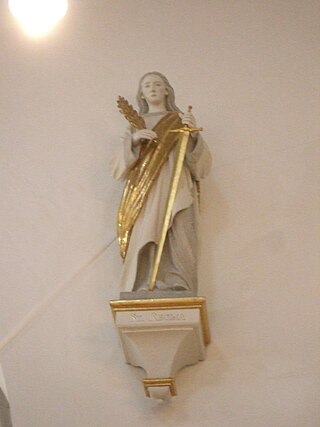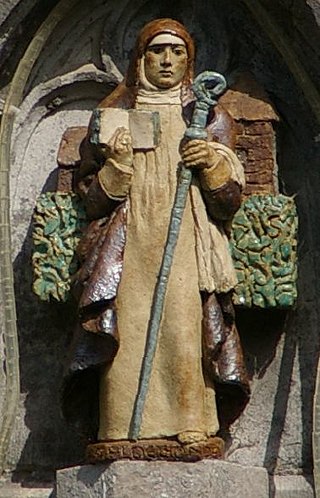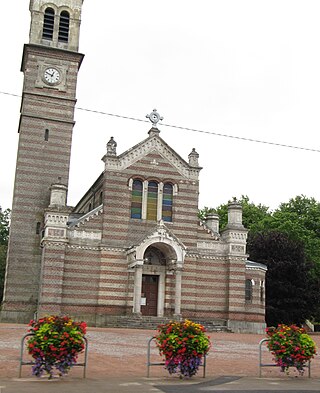
Osgyth was a Mercian noblewoman and prioress, venerated as an English saint since the 8th century, from soon after her death. She is primarily commemorated in the village of St Osyth, in Essex, near Colchester. Alternative spellings of her name include Sythe, Othith and Ositha. Born of a noble family, she became a nun and founded a priory near Chich which was later named after her.
Alban Butler was an English Roman Catholic priest and hagiographer.
Pope Theonas of Alexandria was the 16th Pope and Patriarch of Alexandria, reigning from 282 to 300.

Saint Regina was a virgin martyr and saint of the pre-schism Christian Church. Regina was born in Autun, France, to a pagan named Clement. Her mother died at her birth and her father placed her with a Christian nurse who baptized her. Regina helped out by tending the sheep. She communed with God in prayer and meditated on the lives of the saints. At the age of fifteen, she was betrothed to the proconsul Olybrius, but refused to renounce her faith to marry him, for which she was tortured and was beheaded at Alesia in the diocese of Autun, called Alise-Sainte-Reine after her.

Aldegund, also Aldegundis or Aldegonde, was a Frankish Benedictine abbess who is honored as a saint by the Roman Catholic Church in France and by the Orthodox Church.

Saint Waltrude is the patron saint of Mons, Belgium, where she is known in French as Sainte Waudru, and of Herentals, Belgium, where she is known in Dutch as Sint-Waldetrudis or -Waltrudis. Both cities boast a large medieval church that bears her name.
Saint Faro, Count of Guînes, was bishop of Meaux. The family to which Faro belonged is known as the Faronids and is named after him.
Saint Balderic was the founding abbot of Montfaucon.

Maubeuge Abbey was a women's monastery in Maubeuge, in the County of Hainaut, now northern France, close to the modern border with Belgium. It is best known today as the abbey founded by St. Aldegonde, still a popular figure of devotion in the region. It is thought to have possibly been where the young Jan Gossaert, a Renaissance-era painter known as Jan Mabuse, was educated, claimed by some to have been a native of the town of Maubeuge, which grew up around the abbey.
Saint Thecla of Kitzingen was a Benedictine nun and abbess. Born in England, she went to Germany to assist Saint Boniface in his missionary labors.
Saint Berthild, also known as Bertille or Bertilla, was abbess of Chelles Abbey in France.
Adalbert I of Ostrevent was a 7th-century Frankish nobleman of the court of King Clovis II of France. He is recognized as a saint, and is commemorated on both 2 February and 2 May.

Aldetrude was a Christian saint and from 684 was abbess of Maubeuge Abbey in the County of Hainault, now in northern France. She is also known as Aldetrude de Maubeuge, Aldetrude of Maubod, Aldetrudis and Adeltrude.
Saint Sidronius was a Roman martyr. His life is confused with a French saint of the same name. His feast date is 8 September or 11 July.
Saint Lewina was a British virgin and martyr who was put to death by Saxon invaders. Her feast day is 24 July.

Saint Grimonia was a 4th-century Irish virgin who was martyred in La Capelle, Picardy, France. The town is named after her chapel. Her feast day is 7 September.
Saints Daniel and Verda were Christian martyrs under King Shapur II of Persia. Their feast day is 21 February.
Saint Bain, a disciple of Saint Vandrille, was a bishop of Thérouanne in northwest France, and then abbot of the monastery of Saint Wandrille in Normandy. His feast day is 20 June.

Saint Syra of Troyes was an Irish woman, sister of Saint Fiacre, who became a nun in France and died in Meaux but came to be venerated in Troyes. Her story has been conflated with that of a woman named Syria who died in Troyes in the 4th or 5th century. Her feast day is 8 June.

Saint Silaus of Lucca was an Irish bishop who died in Lucca, Tuscany, while returning from a pilgrimage. His feast day is 17 May.
This page is based on this
Wikipedia article Text is available under the
CC BY-SA 4.0 license; additional terms may apply.
Images, videos and audio are available under their respective licenses.









